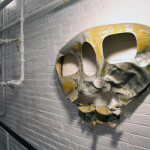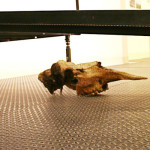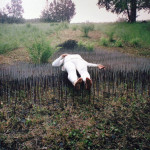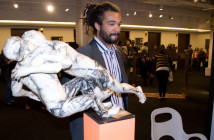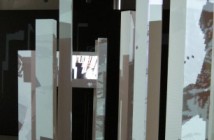ASSESSMENT ALASKA @ THE DISTILLERY GALLERY
In the months leading up to the 2008 U.S. presidential election, Alaska received considerable public attention when its governor was chosen to run for vice president on the Republican ticket. But that's not all that was going on in the Last Frontier that summer: 100 miles north of Anchorage, six artists were engaged in a more thoughtful endeavor--the inaugural season of The Homestead AK artist residency. The Distillery Gallery's current exhibition presents work by Chuck Chaney, The Homestead AK's artist-owner, and other artists from that first residency.
Chaney inherited The Homestead AK, in Alaska's Matanuska Susitna Valley, from his father in 2005. During the 37 years that the elder Chaney lived there, he accumulated enormous quantities of miscellaneous objects, among them 43 cars and 15 other vehicles. (A proclivity for collecting all and sundry is a survival skill when the nearest store is 60 miles away.) When the property passed to the younger Chaney, he recognized these materials as an artist's treasure trove, but of an unruly sort: “... the piles had been sitting around for so long, that not only did things not work as they once used to, many had literally begun to return to the earth.”
Establishing an artist residency seemed like an ideal way to transform the property and its contents into something of value, something that would benefit the larger community. The residency would take a group of artists--in that first season, Chaney and five colleagues from the SMFA's MFA program--out of their frame of reference and probably their comfort zone, transporting them from the sophisticated urban environment in which they had trained to the Alaskan frontier, a wilder, more primitive setting in which “only the strong survive.” It would be a test: would these “new homesteaders” come together as a community and prosper and grow in this exceptional environment, or would the experience overwhelm them?
The Distillery's main gallery--the “art room”--contains a selection of works from the first season. But before you view them, stop in the small room across from the gallery entrance--the “history room”--where Chaney has assembled a photographic essay on the homestead. On the left, two montages document the homestead and its inhabitants from 1958 to 1974. Continuing around the room, Chaney gives us a taste of the work needed to make the site habitable--reroofing the main house, clearing a field, assembling all the vehicles in an orderly array--and then records the residency in a series of informal photographs.
The “art room” works are a mix of sculpture, photography, video, and performance documentation. The most effective are simple iconic objects or expressive personal explorations, the least appear vague, suggesting an artist who was overwhelmed and unsure where to begin. Most works explore the back country's wildness and how humans adapt to it--fire pits, fishing, reuse of objects--and many could have been set in any wilderness locale (for example, northern Maine). Although this is a bit disappointing, it's probably unrealistic to expect work that is specifically, identifiably Alaskan: how can anyone grasp the vastness of Alaska, its moods and temperament, in a few short summer weeks?
Richard Spartos, Thomas Stevenson, and Darren Lee Miller have contributed primarily performance documentation. Among Spartos' works, the most accessible is Sisyphus,which maps moving large objects around the homestead onto the familiar Greek myth. The photographic record includes a stand-in for Sisyphus' boulder: an enormous oil tank viewed end-on. Stevenson, who photographs his own pieces, is the wistful fellow in the center ofThese Days, a reference, perhaps, to the Tom Rush song of the same name. Miller, performing for his own camera, is Seeking Comfort by reclining atop what appears to be a bed of plant stems, but is actually hundreds of welding rods found in the trunk of one of the homestead's derelict vehicles.
Elizabeth Amento, a sculptor, works primarily in fabric and found objects. I can ride it, in the center of the gallery, is easily the largest piece in the show. This vivid assemblage of bulbous, overstuffed cloth shapes and amorphous blobs of spray foam insulation is at once whimsical and biomorphic.
Chuck Chaney has also contributed sculpture, in the form of found objects with an Alaskan resonance: the huge skull of a moose lurks under the staircase, while the nose cone of a small plane, strikingly totemic, stares down from a wall. In addition, he has contributed a number of photographs and video works, including 58, a slide-show catalogue of head-on views of the site's vehicles.
Although for these artists the Alaska experience may represent simply a starting point--a new line of investigation-- many of the works are interesting in their own right. Miller seems particularly adept at placing himself within the landscape; Chaney's iconic nose cone is a reference to a familiar Alaskan symbol, the resolute bush pilots who traverse the largely unpaved interior.
The show as a whole is also worth seeing in order to get a sense of the philosophy behind the new residency program. In the farflung regions of the Alaskan interior, a sense of community is essential to survival: neighbor must help neighbor, both in day-to-day tasks and during crises. Chaney wants each residency season to foster that sense of community among its group members through shared experience--communal meals, site improvement projects, firelight conversations, and trips into the interior--and yet provide a unique context for the development of their individual practices. During future residencies, he hopes that “artists will utilize not only the materials around the property for inspiration, but more importantly the light, the land, and the community itself.”
Author's Note: The website of The Homestead AK is http://www.thehomesteadak.org/. For information about the Homestead Act of 1862, which established homesteading in the Western territories after the Civil War, see http://www.ourdocuments.gov/doc.php?flash=true&doc=31.
- Chuck Chaney’s small-plane nose cone (part of Yellow Is Beautiful)
- Chuck Chaney, Fallen (the moose skull under the catwalk)
- Darren Lee Miller, Seeking Comfort, photograph from the performance
The Distillery Gallery
The Homestead AK
The Homestead Act of 1862
"Assessment Alaska" runs through March 26, 2009 at the Distillery Gallery (516 East Second Street, 1st Floor) in South Boston, MA.
All images are courtesy of the artists and the Distillery Gallery.


